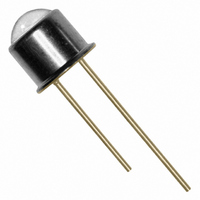OUE8A405Y1 TT Electronics/Optek Technology, OUE8A405Y1 Datasheet - Page 2

OUE8A405Y1
Manufacturer Part Number
OUE8A405Y1
Description
LED ULTRAVIOLET METAL CAN 405NM
Manufacturer
TT Electronics/Optek Technology
Datasheets
1.OUE8A400Y1.pdf
(8 pages)
2.OUE8A400Y1.pdf
(4 pages)
3.OUE8A400Y1.pdf
(3 pages)
4.OUE8A400Y1.pdf
(3 pages)
5.OUE8A400Y1.pdf
(1 pages)
Specifications of OUE8A405Y1
Color
Ultra Violet (UV)
Current - Test
100mA
Current - Max
100mA
Voltage - Forward (vf) Typ
3.3V
Wavelength
400nm ~ 405nm
Lens Style/size
Round, 4.6mm
Viewing Angle
18°
Mounting Type
Through Hole
Package / Case
TO-46
Lead Free Status / RoHS Status
Lead free / RoHS Compliant
Luminous Flux @ Current - Test
-
Other names
365-1514
Ultraviolet Products
Ultraviolet Products
THE UV SPECTRUM
The Ultraviolet spectrum lies between the visible light range the human eye can detect and x-rays. The term Ultraviolet
refers to all electromagnetic radiation with wavelengths in the range of 10 to 400 nanometers. In addition, there are
several classifications inside of the UV range: UV-A, UV-B, and UV-C.
UV-A
Wavelengths in the UV-A range are used for currency validation, industrial curing, phototherapy, and for forensic /
analytical instruments. UV-A wavelengths from 315 to 345 nm are used for sun tanning and are a suspected cause for
premature aging of human skin. Most of the UV-A range can not be seen by the human eye. At approximately 385-
390nm and below the human eye can not detect UV. Therefore it is essential to take precautions to protect your eyes
and skin when working with UV light sources.
UV-B
UV-A wavelengths, and are largely responsible for sunburn. The UV-B range is used in forensic and analytical instruments
and for the more recent narrow band UV-B phototherapy skin treatments for Psoriasis (308-311nm). UV-B does not
penetrate as deeply in the skin as UV-A, however, the deadliest types of skin cancer (malignant melanomas) start in the
epidermis, an upper layer of the skin. UV-B is largely blamed for these cancers although shorter UV-A wavelengths are
considered possibly cancer-causing as well.
UV-C
Deep UV Range. Wavelengths in the UVC range, especially from the low 200’s to about 275 nm, are especially damaging
to microorganism’s DNA. UV-C is often used for germicidal applications for water, air and surface decontaminations. The
earth’s atmosphere absorbs most of the UV-C radiated by the sun.
Vacuum UV – This range has the shortest wavelengths and highest energy level from 10 to 200 nm and are absorbed
by the atmosphere. The strong absorption of Vacuum UV in the Earth’s atmosphere is due to the presence of oxygen.
State of the art semiconductor photolithography processes seek to use shorter UV wavelengths to manufacture the next
generation of smaller IC chips.
Electromagnetic Radiation Spectrum
Some typical effects caused by Ultraviolet Electromagnetic radiation are:
UV-A
UV-A and UV-B
UV-A and UV-B
UV-C
Note: OPTEK UV products are in the UV-A spectrum. This information is provided only for information purposes.
The UV-C range refers to shorter UV wavelengths, usually 200 to 280 nanometers and is sometimes referred to as the
The UV-A range includes wavelengths from 315 to 400 nanometers which have the least amount of energy.
The UV-B range refers to wavelengths from 280 to 315 nanometers. These wavelengths are more hazardous than
Cosmic
Rays
10
Gamma
Many organic & inorganic materials fluoresce under UV light.
Certain materials, such as adhesives and coatings undergo polymerization chemical reactions
(curing) when exposed to UV light.
Electromagnetic radiation is used for phototherapy to treat certain types of skin conditions such as
psoriasis.
DNA of harmful microorganisms can be inactivated by UV radiation which is used in germicidal
applications. The germicidal range is roughly between 225nm and 300nm.
-13
Rays
100
m
Vacuum
UV
185
X-Rays
200
10
Short Wave UV
-9
m
(UV-C)
Ultraviolet
10
254
Violet
-7
m
280
Middle Wave UV
Visible
(UV-B)
300
Red
315
Infrared
Long Wave UV
(UV-A)
Waves
Micro
10
-1
400
m
Waves
Radio
(nm)
m







